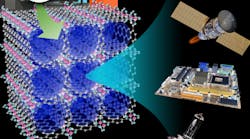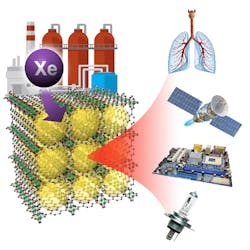Researchers at the Department of Energy’s Pacific Northwest National Laboratory are tailoring metallic organic frameworks (MOFs) to be inexpensive, porous, nanoscale materials that capture and store any available xenon. They have built an MOF, SBMOF-1, that can separate and hold xenon gas at room temperature and may be far less expensive than existing means of producing it.
Currently, industry uses a common but expensive process called cryogenic distillation to separate xenon from other gases or the atmosphere. In that costly process, a lot of energy is used to chill entire gas streams down to far below freezing to concentrate the xenon.
Metallic organic frameworks (MOFs) are quite porous and have a high affinity for xenon. This lets them separate the gas form air or waste streams. The gas could become less costly and used in a variety of industries, including medicine, nuclear power, and semiconductors.
With the new process, users would pass a mixed gas stream over the MOF materials just once to capture xenon and store it (long-term, if need be). It can then be easily released for industrial applications when desired. If the gas is then passed over another array of SBMOF-1, the materials pull xenon out of the stream.
The researchers say xenon use would likely increase if it was more economical to produce. For instance, they point to reports that show xenon is considered a better surgical anesthetic than the existing chemicals as it is more potent, less risky, more environmentally friendly, and potentially recyclable.
Xeon also has applications in lighting, flash lamps, arc lamps, radiation detectors, medical imaging, research imaging with nuclear magnetic resonance, semiconductors, lasers, space propulsion, and nuclear processing.


